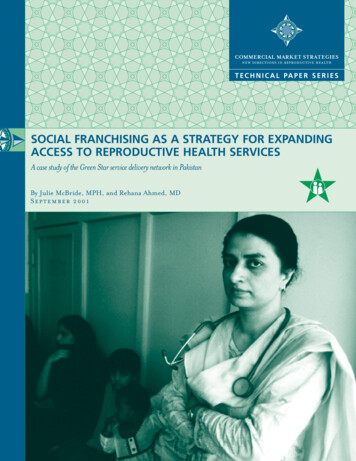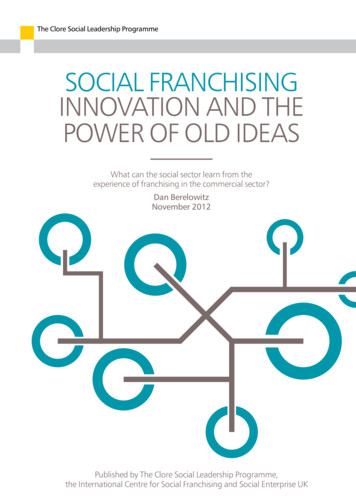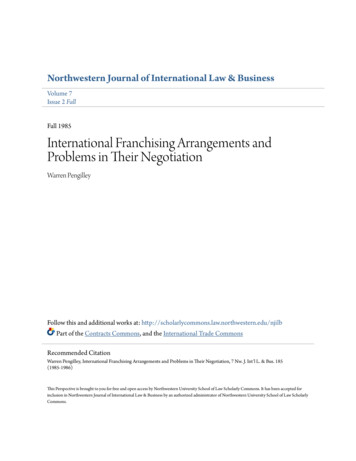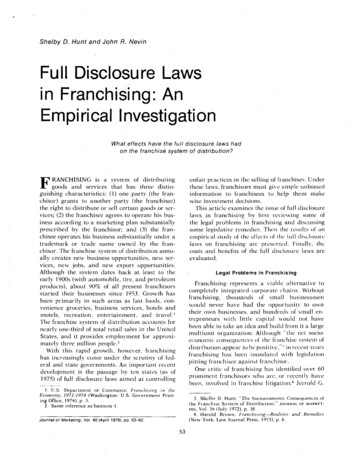
Transcription
COMMERCIAL MARKET STRATEGIESnew directions in reproductive healthT E C H N I C A L PA P E R S E R I E SSOCIAL FRANCHISING AS A STRATEGY FOR EXPANDINGACCESS TO REPRODUCTIVE HEALTH SERVICESA case study of the Green Star service delivery network in PakistanBy Julie McBride, MPH, and Rehana Ahmed, MDSeptember 2001
Social Franchising as a Strategyfor Expanding Access toReproductive Health ServicesA case study of the Green Star service delivery network in PakistanBy Julie McBride, MPH, and Rehana Ahmed, MDSeptember 2001
This publication was prepared by the Commercial Market Strategies Project (CMS). It is intended to serve as a referencefor donors, governments, and potential implementing agencies that wish to address some of the same needs as theGreen Star program. Material from this publication may be reproduced provided CMS and the authors are acknowledgedas the source. Opinions expressed in this report are those of the authors and do not necessarily reflect the views of thesponsoring agencies.This publication was made possible through support provided by the Office of Population, Center for Population, Healthand Nutrition, Bureau for Global Programs, Field Support and Research, U.S. Agency for International Development,under the terms of Contract No. HRN-C-00-98-00039-00. The opinions expressed herein are those of the author(s) anddo not necessarily reflect the views of the U.S. Agency for International Development.
Table of ContentsFigures . iiiTables. iiiContributors. 1About the Green Star Case Study . 3Preface . 5Acknowledgments . 7Acronyms. 9Project Photographs. 11The Green Star Network . 15Introduction . 15Background: The Pakistan Context . 17Family Planning in Pakistan . 17Other Health and Social Indicators in Pakistan . 18The Public Health Sector in Pakistan . 18The Private Health Sector in Pakistan. 19From the Social Marketing of Condoms to Franchising Family PlanningServices: Evolution of the Green Star Network. 20Design . 23Green Star’s Stakeholders. 23Service Delivery: The Franchise Model. 24Operational Components of the Network. 27The Green Star Brand . 28Assuring Quality Franchisees . 31How the Components Work Together. 38Green Star Management . 38Implementing the Green Star Network. 41Evaluation. 41Refinement . 43Expansion . 43i
Achievements . 45Expanded Access to Family Planning . 45Improved Quality of Family Planning Services. 47Increased Use of Family Planning Services and Methods. 48Green Star’s Sustainability . 57Problems and Challenges . 61Compliance with Green Star Quality Standards . 61Mechanisms to Control Pricing . 61The Need For Immediate Results . 62Maintaining Provider Skills. 62Managing a Rapidly Growing Network . 62Sustaining Provider Involvement . 63The Future of Green Star: Next Steps . 65Raising the Standard of Care . 65Strengthening Franchisee Business Practices . 65Increasing Client Flow. 65Expanding the Network’s Reach . 66Green Star Plus: Establishing Integrated Hubs . 68Monitoring, Evaluating, and Disseminating Results . 68Lessons Learned from the Green Star Experience . 71Project Design . 71Implementation . 73References . 77Appendix A: Green Star Monitoring & Evaluation Tools. 81Clinic Grading Checklist . 81Supervisory Activity Sheet . 82Appendix B: Green Star Network’s Provider Service-Delivery Protocols . 83Choice of Methods . 83Information Exchange. 83Technical Competence. 83Interpersonal Relations . 84Continuity of Care. 84Acceptability and Appropriateness of Services . 84ii
FiguresThe Green Star Network in Pakistan (location of provider training sessions). 16Contraceptive Methods Used in Pakistan. 18Milestones in Green Star’s Development. 21History of PSI/SMP funding in Pakistan — Project Implementation Structure . 22National CYP growth, 1994–2000 . 54Couple-years of protection generated by Green Star products. 55Growth in the contraceptive prevalence rate, 1990–99 . 57Total PSI/SMP cost per couple-year of protection, 1987–2000 (years 1– 14) . 58Cost per CYP since Green Star began, 1995–2000 (years 1– 5). 60TablesGrowth of the Green Star Network. 43Estimated family planning client visits received by Green Star. 48Total Pakistan oral contraceptive market, 1994–2000. 49Total Pakistan injectable market, 1994–2000 . 50Total Pakistan IUD market, 1994–2000. 51Pakistan condom market . 52PSI/SMP CYPs generated since Sathi was launched in 1987 . 53Total CYPs from modern methods in Pakistan, 2000. 53National CYP growth, 1994–2000 . 54Couple-years of protection generated by Green Star products. 55Growth in total demand for family planning and demand satisfied . 56Pakistan contraceptive prevalence. 56Cost per couple-year of protection, 1987–2000 (in US ). 58Cost per CYP since Green Star began, 1995–2000 (in US ) . 59iii
ContributorsThe Commercial Market Strategies ProjectThe Commercial Market Strategies (CMS) project is a recognized leader in private sectordevelopment for reproductive health and family planning. Funded through a five-year contract(1998–2003) with USAID, CMS works to increase access to and demand for reproductive healthand family planning in developing countries through the private sector. The CMS project hasworked in over 25 countries and has fully staffed program offices in over seven countries.The CMS project is implemented by a consortium of organizations: Deloitte Touche Tohmatsu(prime contractor), Abt Associates, Meridian Group International and Population ServicesInternational.CMS produced the Green Star case study to serve as a reference for donors, governments,researchers and potential implementing agencies.Population Services InternationalPopulation Services International (PSI) develops and implements programs worldwide toempower low-income individuals and communities to lead healthier lives. A nonprofit groupheadquartered in Washington with projects in more than 50 countries on five continents, PSI isone of the world's leaders in social marketing.Social Marketing PakistanSocial Marketing Pakistan (SMP) is a Pakistan-based NGO established by PSI in 1991 at therequest of USAID and the Government of Pakistan. SMP was designed to expand PSI’sfunctional role in the project and to operate the franchise. SMP and PSI operate as a joint venture.PSI has a minority share on the SMP board and an important, though not decisive, voice in SMPstrategic matters.About the AuthorsJulie McBride has been with PSI since 1995. She spent two-and-one-half years in Pakistancontributing to the development of the Green Star project, specifically by adding hormonalcontraceptives to the product line. Since 1998, she has been based out of PSI’s Washington, DC,headquarters, where she specializes in developing and marketing pharmaceutical products andhealth services for PSI programs worldwide. Ms McBride’s professional background includespharmaceutical marketing, sales, and advertising in the commercial sector. She received herMaster’s degree in Public Health from New York University in 1995.Rehana Ahmed, MD, served as National Medical Coordinator of Social Marketing Pakistan(SMP) from 1995 to 2000, and as Director of Health and Training and a member of the SMPBoard of Directors from 2000 to the present. Dr Ahmed has also held leadership positions withthe Family Planning Association of Pakistan, lectured at the Aga Khan University in Pakistan,and practiced as an ObGyn in both England and Pakistan. She received her Bachelor’s ofMedicine and Surgery from Karachi University in 1967.1
About the Green Star Case StudyThis case study chronicles Social Marketing Pakistan’s experience designing and implementingthe Green Star Network as documented and interpreted by Population Services International(PSI). Social Marketing Pakistan (SMP) and PSI operate as a joint venture, with SMP functioningas a local affiliate.As the Green Star Network is often cited as an example of a successful social franchise, theCommercial Market Strategies (CMS) project produced the case study to illustrate how thismodel can expand access to quality reproductive health products and services. CMS works toexpand access through the private sector and often uses franchising and networking strategies toachieve this goal.3
PrefaceIn 1996, Population Services International (PSI) and Social Marketing Pakistan (SMP), inconjunction with the Government of Pakistan, began implementing an innovative program tooffer family planning services and a range of contraceptive products — including oralcontraceptives, injectables, and IUDs — to low-income urban women. Pakistani women have, onaverage, more than five children. This high fertility rate, combined with a young population, hasmade Pakistan the world’s sixth most populous nation and the third most significant contributorto worldwide population growth. At the same time, the majority of married Pakistani women ofchild-bearing age say that they do not wish to become pregnant, yet only 24 percent are using afamily planning method of any kind — and nearly one third of these women rely on traditionalmethods of family planning.To address this clear, unmet need, PSI and SMP created Green Star. Green Star is a network offamily-planning franchises: privately owned and managed clinics and pharmacies in low-incomeurban areas that offer reliable family-planning services and quality contraceptive products underthe Green Star logo. The Green Star Network is a great success. In its first five years (1995–2000)Green Star grew to include nearly 12,000 doctors, paramedics and pharmacists in more than 40cities, and provided more than 900,000 couple-years of protection to Pakistani women and men.Green Star’s success — and the success of similar programs in other countries — illustrates thepower of social franchising to do for social services what it has done for fast food: take asuccessful small-business model and copy it quickly, faithfully, and on a strikingly wide scale.Social franchising is just one of many ways in which public–private partnerships and theinnovative use of private-sector insights and techniques are helping to make social services moreaccessible to individuals, families and communities around the world.In this case study, Julie McBride and Rehana Ahmed — two of the people who helped build theGreen Star Network — discuss their experiences in detail, including: The social and economic conditions that helped make franchised family planningpossible in Pakistan: an unmet demand for family planning services, a population willingto pay for health care and an untapped capacity among private health-care professionalsto provide family-planning services. The specific assets and tools necessary to successful franchising: the business model,training, quality assurance, etcetera. Lessons learned from Green Star’s mistakes.By documenting their experiences with Green Star, the authors hope to help others working inthis important and rewarding field.5
AcknowledgmentsThanks to Ann Covalt, Craig Carlson, Holly Stewart and Christine Prefontaine for editorialassistance and Dana Hovig, Jackie Gaskell, Will Warshauer, John Hetherington, Sohail Agha,Carlos Cuellar, and Asma Balal for their technical input. And thanks also to Sue Wood whoprovided final design, layout and production assistance on this document.Credit is due to all those who have contributed to the development and ongoing operations of theGreen Star project, including Zafar Iqbal, Social Marketing Pakistan’s Chairman of the Board,and Riaz Mahmood, SMP’s Chief Executive Officer, and all the hard-working SMP staff. SeveralPSI staff have contributed to Green Star’s design, development, and operations over the years,including Dana Hovig, Carol Squire, Will Warshauer, Jackie Gaskell, John Hetherington, SohailAgha, Dominique Meekers, Dick Johnson, Steve Chapman and Judith Timyan.CMS, PSI and SMP are extremely grateful to the agencies that have contributed funds to supportthe Green Star project, most notably the United States Agency for International Development forfunding this study and to Germany’s Kreditanstalt fur Wiederaufbau and the Packard Foundation,without whom the project would not have been possible.7
AcronymsAID/WUnited States Agency for International Development/WashingtonAIDSacquired immunodeficiency syndromeANCantenatal careCBDcommunity-based distributionCBOcommunity-based organizationCBTcompetency-based trainingCMSCommercial Market Strategies projectCPRcontraceptive prevalence rateCSMcontraceptive social marketingCSRcorporate social responsibilityCYPcouple-year of protectionDFIDDepartment for International Development (UK)DHSdemographic and health surveys (produced by Macro International,see References)ECemergency contraceptionFPfamily planningFPAPFamily Planning Association of PakistanFPSDFamily Planning Services DivisionGDPgross domestic productGoPGovernment of PakistanGSNGreen Star NetworkGS1Green Star 1 ProvidersGS2Green Star 2 ProvidersGS3Green Star 3 ProvidersGS4Green Star 4 ProvidersHIVhuman immunodeficiency virusIECinformation, education and communicationIUDintrauterine deviceJHPIEGOJHPIEGO Corporation: A non-profit affiliate of Johns Hopkins UniversityKfWKreditanstalt fur WiederaufbauKSMKey Social Marketing Program (The Futures Group International)LHVslady health visitorsMCHmaternal and child health9
MDmedical doctorM&Emonitoring and evaluationMoHMinistry of Health [Pakistan]mohallaEnglish translation: neighborhoodMoPWMinistry of Population Welfare [Pakistan]MOUmemorandum of understandingMSIMarie Stopes InternationalMWRAmarried women of reproductive age (15–49)NDFCNational Development Finance CorporationNGOnongovernmental organizationNIPSNational Institute for Population Studies [Pakistan]OCoral contraceptiveORS/ORToral rehydration salts/therapyPACpost-abortion carePHNpopulation, health and nutritionPNCpostnatal carePOPpoint of purchasePRBPopulation Reference BureauPSIPopulation Services InternationalPVOprivate voluntary organizationRHreproductive healthRHCreproductive health careRsrupees (Pakistan’s currency)RTIreproductive tract infectionsSMPSocial Marketing PakistanSTD/STIsexually transmitted diseases/infectionsTAGtechnical advisory groupTFGIThe Futures Group InternationalUNFPAUnited Nations Population FundUSAIDUnited States Agency for International DevelopmentVCTvoluntary counseling and testingVSCvoluntary surgical contraception10
[1]
[2][1] Friendly client/provider relations are animportant part of the quality of care at GreenStar clinics. A client who is happy with theservice is much more likely to return to the clinic,and to tell her friends.[2] Atiqa Odho, a famous and well-respectedPakistani film actress, was the Green Starspokesperson for several years.[3] The Green Star model franchises already existingclinics. These clinics delivered health services tolow income women before SMP arrived, andmost will continue to deliver an improved andexpanded range of services to Pakistani womenlong after donor funding ends. In this way, thesocial franchising model is sustainable.[4] SMP places Green Star sign boards over clinicswhich have completed training and been certifiedby SMP staff. These signboards are featured in allmarketing efforts, and potential clients areencouraged to look for the Green Star fortrustworthy family planning products and services.[5] The Green Star model includes training offamily planning providers. Dr Alia Mohallahspeaks to a group of women at the clinic ofa Green Star lady doctor.[6] Low-income women and their children arethe principal focus of Green Star marketing,outreach and service delivery efforts. MostGreen Star clinics are situated in urban slumsand low-income neighborhoods and towns.[3]
[4][5]
[6]
The Green Star NetworkIntroductionRapid population growth and the poor health status of women in Pakistan are to a large extentconsequences of an inadequate health care system, particularly the inability of the system to meetwomen’s reproductive health needs. While Pakistan can be credited with having one of theworld’s oldest national family planning programs, inconsistent strategies and weakimplementation have resulted in ongoing program failures. Resource constraints have also placedserious limitations on the public sector’s ability to provide access to quality reproductive healthservices. The private sector, while playing a significant role in health care delivery in Pakistan,has had only limited involvement in the provision of family planning services. As a result,geographic coverage of family planning services is inadequate, with services accessible to only25 percent of the population (Rosen, 1996).In recognition of the need to expand access to family planning, the Government of Pakistan(GoP) developed a national plan to extend services to rural areas by providing training to femalehealth workers posted in rural health centers (GoP, 1999). At the same time, to enable thechanneling of government resources toward meeting rural needs, Pakistan sought ways to involvethe private sector in expanding access in less developed urban areas. Population ServicesInternational (PSI) and its local affiliate, Social Marketing Pakistan (SMP), designed the GreenStar Network of family planning service providers to contribute to the Government of Pakistan’sfamily planning goals by complementing its rural-based public service expansion strategy with anurban-based private sector strategy.The Green Star Network was designed to harness the potential of private sector health providerswho were willing to upgrade their knowledge and skills in order to add family planning to theservices they offered. In 1995, SMP began implementing the Green Star Network with fundingfrom the government of Germany’s Kreditanstalt für Wiederaufbau (KfW). The aim of the GreenStar Network is to contribute to increased use of contraception by making high quality familyplanning services and products more widely available and affordable to low-income peoplethroughout urban Pakistan.1In its first five years (1995–2000), the Green Star Network grew to include more than 11,000private health providers in more than 40 cities, receiving more than 10 million client visits peryear. Figure 1 on the next page uses the location of Green Star Provider training sessions toillustrate the geographic distribution of the network. Over the same period of time, contraceptiveprevalence rates among married women of reproductive age in Pakistan increased from 17.8percent in 1995 to 23.9 percent in 1997. Further, while the use of oral contraceptive pills (OCs)and injectable contraceptives (injectables) in Pakistan remained virtually unchanged between1991 and 1995 (prior to Green Star) both methods experienced a dramatic rise in use between1995 and 1997. OC use increased by 29 percent and injectable use increased by 40 percent. IUDuse also increased substantially — 62 percent — over the same period of time (Pakistan DHS,1992; Population Council, 1998; NIPS/LSHTM, 1998).1 Low-income people are those earning between 4,000 and 6,000 rupees [Rs] per month.15
The success of the Green Star Network demonstrates that good family planning services can bedelivered effectively and efficiently to low-income populations through the private sector ifhealth providers are equipped and motivated to do so. By designing the Green Star Network tooperate as a social franchise, SMP provided both the means (through training, ongoing technicalsupport, supplies of contraceptives and information, education, and communication materials)and the incentive (increased clientele through affiliation with the Green Star brand) to healthproviders to deliver quality services. The results have been extremely positive.This case study outlines the principles behind the design of the network and its variousoperational components, achievements and challenges. It also documents the development andgrowth of the Green Star Network and shares hard-gained experience that may be valuable toothers who are designing and/or implementing similar programs.Figure 1: The Green Star Network in Pakistan (location of provider training sessions)16
Background: The Pakistan ContextPakistan has a population of 150 million (PRB, 2000). It is the world’s sixth most populousnation and the third most significant contributor to worldwide population growth. High fertilityrates (5.6) combined with a young population (43% below the age of 15) put Pakistan’spopulation growth rate at approximately 2.8 percent per year in 2000 (PRB, 2000) — higher thanthat of any other large Asian nation. At this rate, Pakistan’s population will double in just 25years (PRB, 2000), resulting in a dramatically increased burden on already scarce resources. Percapita income (based on GDP) in Pakistan is currently just US 470 per year. An estimated 34percent of the population lives below the national poverty line (World Bank, 2000). During the1990s unemployment doubled in Pakistan and poverty grew by 41 percent. In just four years, theproportion of people consuming fewer than the recommended 2,200 calories a day increased by32 percent (NIPS/LSHTM, 1998). Population pressures are degrading natural resources such asarable land and water at an alarming rate (Rosen, 1996). Already, 60 percent of Pakistan’spopulation has no running water or other basic amenities.Family Planning in PakistanAlthough population growth in Pakistan is high, national trends in family planning are positive,with fertility rates declining and contraceptive use increasing. At the same time, there is muchprogress to be made. Successive fertility surveys have documented a large and consistent unmetdemand for family planning. The latest such study (NIPS/LSHTM, 1998) reveals that while 61percent of married women of reproductive age (15–49 years old) say that they are currentlysexually active but do not wish to become pregnant at this time, only 24 percent are using afamily planning method of any kind. The remaining 37 percent are at risk of having anunintended pregnancy.Among women using contraception, a large proportion (30%) relies on traditional methods offamily planning, which are not as effective as modern methods. The remaining women usesurgical contraception (25%), condoms (17.7%), IUDs (14.4%), oral contraceptives (6.9%) andinjectables (5.9%) — see figure 2, below. Use of female-controlled spacing methods — IUDs,oral contraceptives, and injectables — is particularly low and represents a much smallerproportion of the method mix than in most other Asian countries. Moreover, contraceptivediscontinuation is over 80 percent for women who have ever used pills or injectables and over 60percent for those who have ever used an IUD. Women cite side effects as a primary reason fordiscontinuing their method (NIPS/LSHTM, 1998; SMAR, 1996).17
Figure 2: Contraceptive Methods Used in PakistanSource: NIPS/LSHTM, 1998. Numbers do not add to 100 percent because of rounding.Pakistan’s low contraceptive prevalence rate (CPR) has been attributed to several factors,including: insufficient public sector supply of family planning services; inconsistent availability of contraceptives; and a lack of accurate, reliable information about family planning methods — for healthproviders as well as consumers.Other Health and Social Indicators in PakistanOther health and social indicators reflect the poor circumstances of women in Pakistan. In 1997,45 percent of women of reproductive age were found to be anemic (NIPS/LSHTM, 1998), afactor associated with maternal deaths as well as malnutrition. More than three-quarters (76%) ofall adult women in Pakistan are illiterate (World Bank, 1997). The country is one of the few in theworld with a higher number of men than women — there are 92 women for every 100 men(World Bank, 1997) — owing in large part to the low social status of women and the impact oftheir consequent treatment on health. Maternal and child mortality rates are correspondingly veryhigh: one child dies for
Social franchising is just one of many ways in which publicŒprivate partnerships and the innovative use of private-sector insights and techniques are helping to make social services more accessible t










